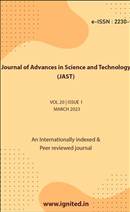To Analysis the In Situ Structural Assessment and Strengthening of Disaster Affected Structures
DOI:
https://doi.org/10.29070/2japgm16Keywords:
in situ structural assessment, strengthening, disaster affected structures, metro cities, residential and commercial buildings, fire incident, structural stability, structural audit, mapping of damage, NDT techniquesAbstract
In India specifically in Metro Cities the residential and commercial buildings constructionrapidly increases. The mass of Population and several commercial area are associated in comparativelysmall area due to land rate and other reasons in metro cities .But due to quite a lot of reasons eithermanmade and natural theses structure affected by disaster .Fire is one of the major source of such kindof disaster in metro cities because if these kind of fire disaster use of that structure is not to be done byoccupants due to these the financial loss may take place and it is also not economical to demolish thebuildings and build a new building. To avoid the loss the buildings structural audit is necessary to checkits structural stability after fire disaster and the strengthen of building by appropriate method is verymuch essential After a fire incident the first question from a structural point of view is whether theconstruction can be refurbished or, in extreme cases, needs to be replaced. The choice of action must bebased on an assessment of the status of the structure. This assessment is in turn based on a mapping ofdamage to the construction. The mapping of damage needs to be accurate to optimise both the safetylevel and the best solution from an economic point of view. The traditional assessment methodsincluded in the experimental part of the research are rebound hammer, ultrasonic pulse measurementsand microscopy methods. These are compared to optical full-field strain measurements during acompressive load cycle on drilled cores, i.e. the new method proposed to determine the degree ofdamage in a fire exposed cross-section. Based on the results from the present study an approach withtwo levels of complexity is recommended. The initial level is to perform an inspection and determine thedevelopment, size and spread pattern of the fire .In this research initially study the different NDTtechniques. Then next phase the in situ assessment of fire affected building by taking suitable casestudies and evaluated the actual structural damage of building and appropriate method for strengthen ofbuilding will be suggested by studying the cost effectiveness of each methodDownloads
References
Mazza and Imbrogno (2019) “Effect of Fire duration on Seismic Reinforcement “Jornal of Built Environment,Volm 7,Page 140-147.
Jun Zhou and Lu Wang (2019) “Repair of Fire-Damaged Reinforced Concrete Members with Axial Load: A Review”
Wenxian Ma, Chunxiang Yin, Jun Zhou and Lu Wang (2019), “Repair of Fire-Damaged Reinforced Concrete Flexural Members: A Review”
Marco Di Ludovico (2018),” Advanced materials for seismic retrofit of existing reinforced concrete buildings with poor quality concrete” Journal of Civil & Environmental Engineering | ISSN: 2165-784X | Volume 8 pp 69-74.
Antonio Brancaccio (2018) In-Situ Structural assessment and FRP Strengthening of a Fire Damaged RC Structure: A Case Study”, International Journal of Civil Engineering Research.ISSN 2278-3652 Volume 8, Number 4 pp.21-56.
Er. Neha Goyal, Er. Bhavana Arora, Dr. Sanjay Sharma, Dr. Arvind Dewangan (2018),” Performance Evolution and Audit of Structure by NDT Methods” International Journal of Engineering Research And Management (IJERM) ISSN: 2349- 2058, Volume-05, Issue-09
Totsawat Daungwilailuk,, Thi Nguyen Cao, Withit Pansuk, and Phoonsak Pheinsusom (2017),”Evaluating Damaged Concrete Depth in Reinforced Concrete Structures under Different Fire Exposure Times by Means of NDT and DT Techniques” Engineering Journal Volume 21 Issue 7, ISSN 0125-8281.
M H Osman, N N Sarbini, I S Ibrahim, C K Ma,M Ismail and M F Mohd,” A case study on the structural assessment of fire damaged building”(2017) IOP Conf. Series: Materials Science and Engineering 271.
Rushabh Karnavat, Vivek Singh (2017), “Structural Audit: A Need of an Hour” International Journal for Scientific Research & Development| Vol. 5, Issue 04.
Fawad Ahmed Najam (2017), “Nonlinear Static Analysis Procedures for Seismic Performance Evaluationof Existing Buildings-Evolution and Issues”
Subodh.S.Patil, Chetan.R.Shah, Rahul.A.Patil, Sunil.D.Bedege (2017), “Push Over Analysis of Multi-Storied Building”






